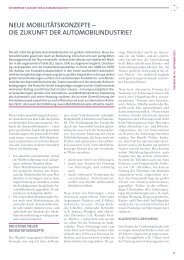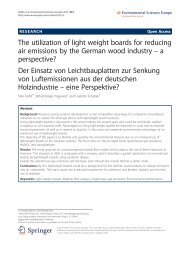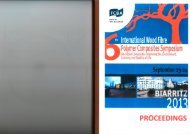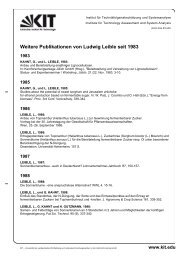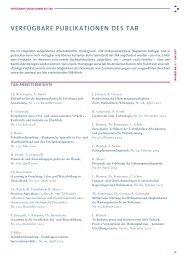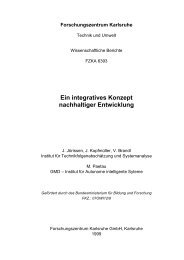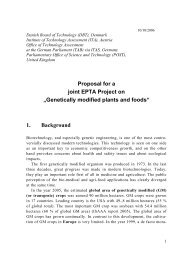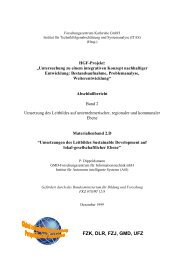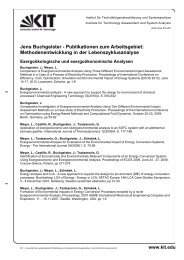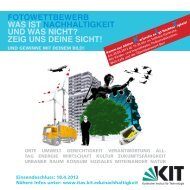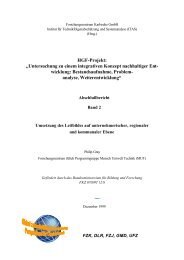Results: RFID and Identity Management in everyday life - ITAS
Results: RFID and Identity Management in everyday life - ITAS
Results: RFID and Identity Management in everyday life - ITAS
Create successful ePaper yourself
Turn your PDF publications into a flip-book with our unique Google optimized e-Paper software.
Case #130: Apenheul<br />
Case ID # 130, level 3<br />
Title Track<strong>in</strong>g visitors flows through the tagged Monkey Bag<br />
Researcher Christian van ‘t Hof<br />
Tim<strong>in</strong>g 2006<br />
Geography The Netherl<strong>and</strong>s<br />
Environment Leisure<br />
Technology The system consists of active <strong>RFID</strong> tags sowed <strong>in</strong>to the visitors bags <strong>and</strong> 11 reader/buffers<br />
def<strong>in</strong><strong>in</strong>g 10 areas through the park. The readers are st<strong>and</strong> alone, their data is downloaded weekly.<br />
Numbers of visitors per area, time spend en speed of movement through the park are provided <strong>in</strong><br />
Excel <strong>and</strong> Acces spreadsheets. Visitors profiles <strong>and</strong> an overview of the total flow of visitors<br />
emerge after analysis.<br />
Costs Each <strong>RFID</strong> tag costs €. 25,-, the whole system about € 20.000,-<br />
Maturity just implemented<br />
Function Profil<strong>in</strong>g flow of visitors through the park<br />
Owner Apenheul, a Dutch zoo specialised <strong>in</strong> monkeys <strong>and</strong> apes<br />
Ma<strong>in</strong>ta<strong>in</strong>er Wavetrend<br />
Users Visitors of the park<br />
Other actors Monkeys <strong>and</strong> apes<br />
ID issue This <strong>RFID</strong> application touches upon the issue on what is personal data <strong>and</strong> the control costumers<br />
should have over data retrieved from their movements. The Monkey Bag <strong>RFID</strong> has a market<strong>in</strong>g<br />
function: how do visitors move through the park <strong>and</strong> the flow of people be optimised. The visitors<br />
rema<strong>in</strong> unanimous, are not traced real time <strong>and</strong> do not receive any consequences accord<strong>in</strong>g to<br />
the data they provide. In that sense, the data retrieved cannot be seen as an identity that should<br />
be managed from a user perspective.<br />
Still, visitors are be<strong>in</strong>g traced without <strong>in</strong>formed consent. The tagged bags are provided without<br />
<strong>in</strong>form<strong>in</strong>g it’s user on the tractability. Moreover, the use of the monkey bag is obligatory. Visitors<br />
are given a bag at the entrance with a security argument “Monkeys move freely through the park<br />
<strong>and</strong> will try to steal your goods.” Although legitimate <strong>in</strong> itself, this rule limits free choice of the<br />
visitors not to use the bag.<br />
A side issue on <strong>Identity</strong> <strong>Management</strong> is that the bag is sometimes used by park hosts, to carry<br />
food across the park. In order to keep the profiles clean, data on personnel movements need to<br />
be erased.<br />
Case story The Apenheul is a zoo specialised <strong>in</strong> all k<strong>in</strong>ds of apes <strong>and</strong> monkeys. An outst<strong>and</strong><strong>in</strong>g feature of the<br />
park is the opportunity for some k<strong>in</strong>ds of monkeys to move freely through the crowd of visitors.<br />
Curious as they are, the monkeys often try to steal or open bags of visitors <strong>in</strong> the hope to get a<br />
free lunch. To prevent this, the park <strong>in</strong>troduced the “Monkey bag”, a green bag with an extra clip<br />
lock which the monkeys cannot open. This bag is obligatory, which is enforced by the<br />
receptionists provid<strong>in</strong>g the bag at the entrance of the park <strong>and</strong> a warn<strong>in</strong>g sign.<br />
Aside from this security reason for implement<strong>in</strong>g the bag, the department of market<strong>in</strong>g added a<br />
market<strong>in</strong>g feature to the bag: scann<strong>in</strong>g visitors movements through the park. Currently about 200<br />
of the 3000 bags are tagged. In order to provide a representative sample of visitors, the tagged<br />
bags are h<strong>and</strong>ed out r<strong>and</strong>om, add<strong>in</strong>g to 1 <strong>in</strong> 15 visitors tracked. A dataset of 90.000 read<strong>in</strong>gs<br />
provided the data to analyse for visitors flows. If for example an area receives too few visitors, it<br />
presumably needs to be made more attractive. If the area receives the most visitors, it’s probably<br />
a hit. Also, if visitors demonstrate a pattern of “gett<strong>in</strong>g lost”, e.g. mov<strong>in</strong>g back <strong>and</strong> forth a lot<br />
between two area’s, the directions need to be changed. F<strong>in</strong>ally the overview of visitors flows can<br />
detect congestion spots that need to be relieved. Odd rout<strong>in</strong>gs are filtered out of the database<br />
manually. For example tags that did not pass the first reader, only passed less than five readers<br />
or move real fast are presumably personnel carry<strong>in</strong>g the bags. In this way, the system manages<br />
identities through differentiat<strong>in</strong>g between personnel <strong>and</strong> visitors.<br />
89



